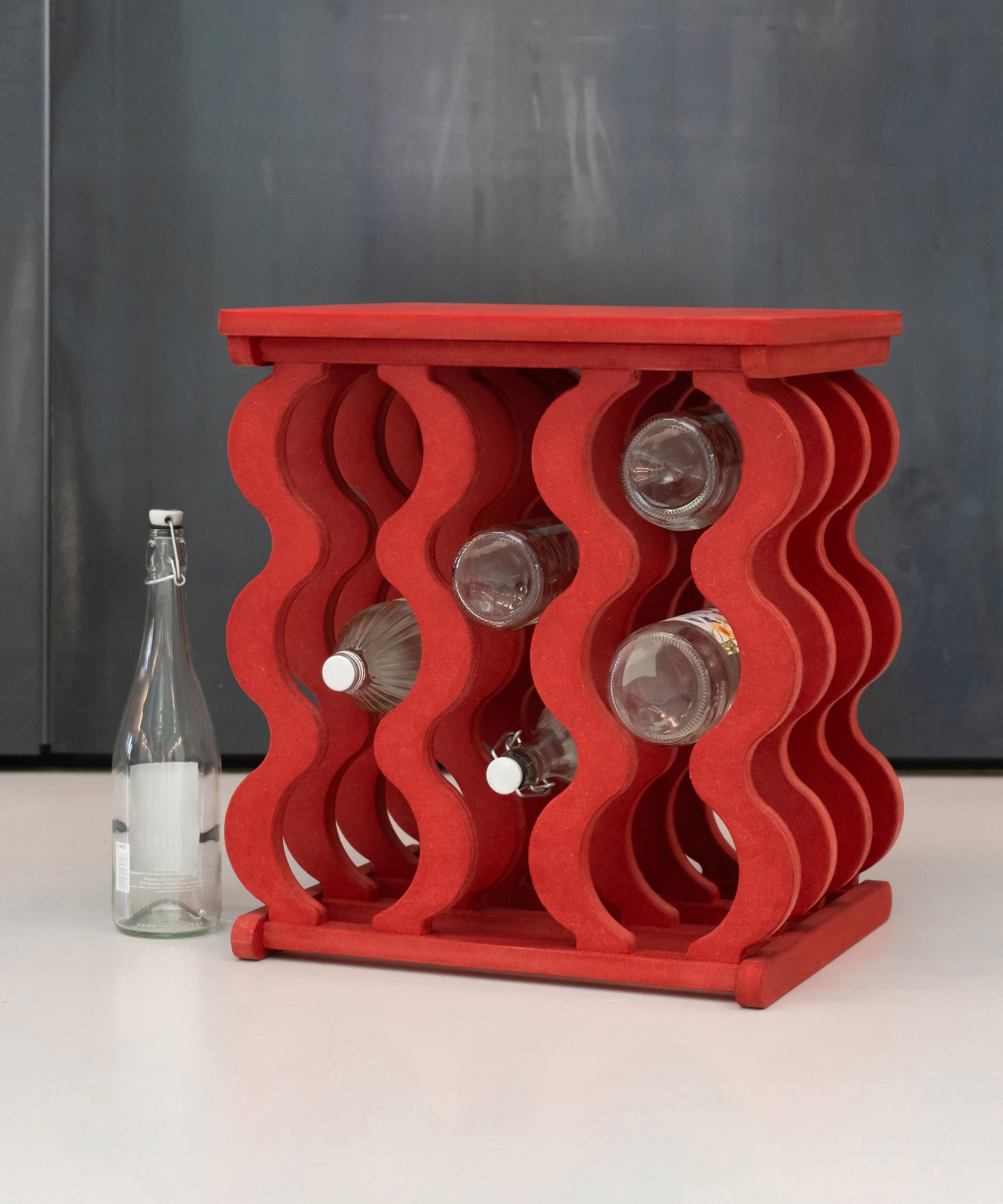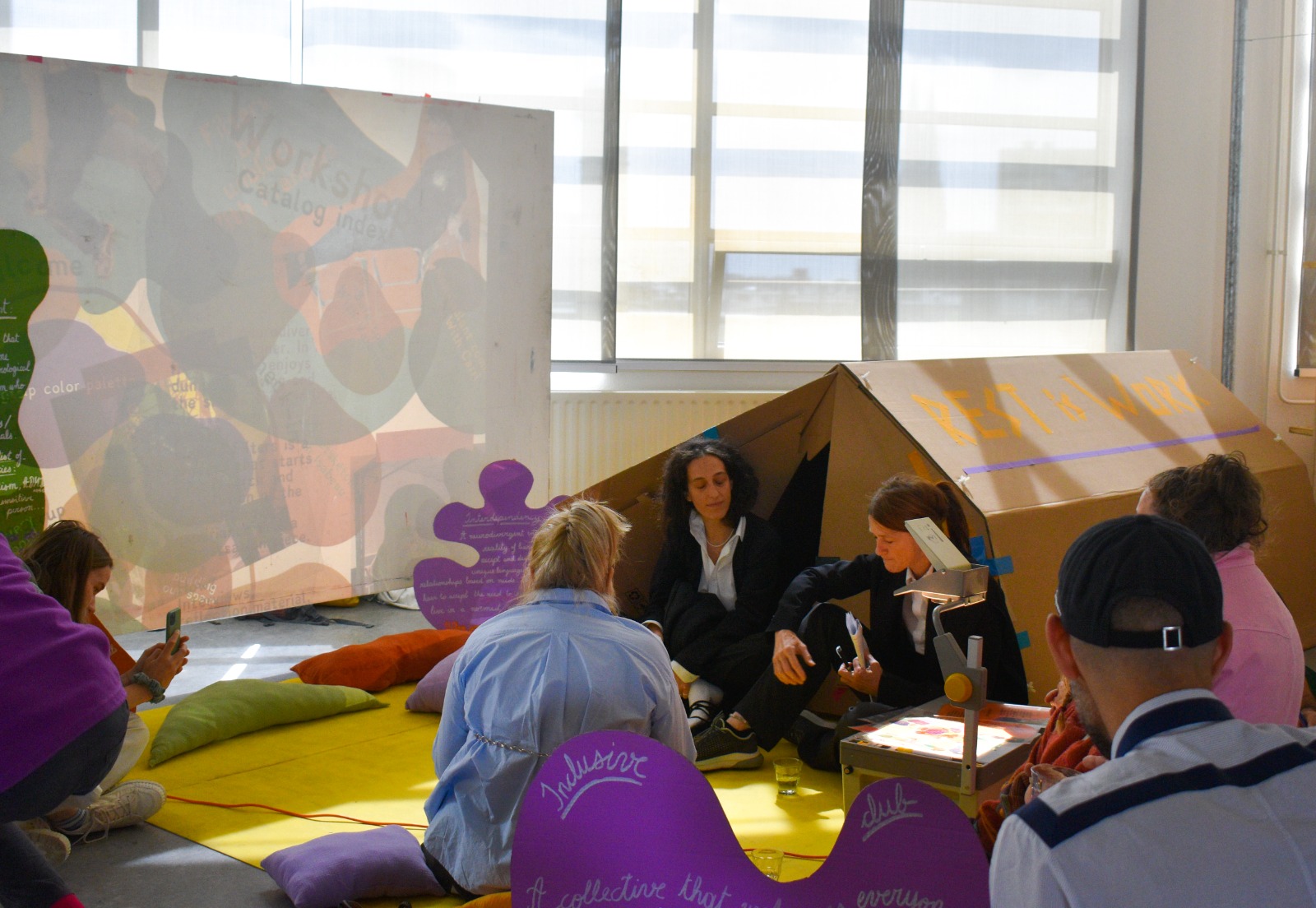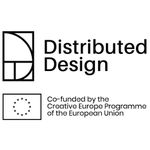In order to tackle the many societal and environmental problems at hand, designers have come up with creative and innovative solutions. Countless ideas and projects are being realised that could help us waste less, build regeneratively, use technology in an ethical manner, understand each other better, etc. However, upscaling these ideas to a level where they can make a broad societal impact, as well as sustaining the designers is difficult. In this article we would like to introduce you to some designers and their innovative projects that are trying to make a positive imprint on the world. Their ideas are in line with the values of distributed design: Open, Collaborative, Regenerative, and Ecosystemic. What are their dreams? And what challenges do they face and what do they need to overcome them?
Maria Levitskaya – Project “Feel Refill” (Prostor Studio)
To provide people with a nice way of storing their recycling bottles, Maria came up with a design that also functions as a multifunctional furniture piece. This simple piece is made out of recycled wood fibers and non-toxic organic dyes. It can be assembled at home with just a screwdriver and its separate components are made to optimise material use for a more eco-friendly and cost-effective manufacturing process.
Prostor Studio stands for a transparent design process. They show every step leading up to their final product and share the designs of their pieces on their website. This allows customers to make the designs themselves with materials they already have or customise the piece to their liking. Additionally, they involve customers in the design process by organising workshops where they can share their insights and preferences, shaping the final product.
Ultimately, Maria’s furniture piece serves only as an example of everything that is possible with this way of design thinking. Her dream would be to see the project develop into a city furniture unit. This way, cities could function as recycling hubs through the integration of a deposit refund system with urban furniture. This could increase recycling rates as well as shift citizens’ consciousness towards sustainable living.

Davide Onestini – BY THE END OF MAY (Post Paper Studio)
Davide’s project was developed as a response to the increasing paper and cardboard waste due to companies switching from plastic to paper packaging. Even though paper can be recycled well, it often happens in large-scale centralised facilities abroad. Post Paper Studio therefore aims to be a low-tech alternative to upcycle paper waste at a local level, promoting its value as material for both design and construction. It consists of a series of recipes, tools, processes, and guidelines to enable designers, makers, and small businesses to transform paper waste from their own communities and use it in place of conventional materials.
The goal is to create an urban self-sufficient ecosystem of community workshops dedicated to paper recycling at a neighbourhood scale. Overall, the open source and low-tech nature of the project wants to turn the recycling practice from centralised and exclusive, to distributed and accessible, sparking a conversation around the efficiency of the current recycling system.
His dream for the project is clear: “We hope that one day if you wish to have your own paper waste transformed into an object you need, you have the possibility to go to a local paper recycling store, bring your waste, and see it molded according to your particular demand. And those stores of this type, working like micro ateliers, could pop up around the world in every city – just like bakeries.”

Peyton Gibson – Autodesk: Driving community wellbeing through digital built environment processes
Peyton is working with large Architecture/Engineering/Construction firms on how to integrate social impact and sustainability into their technology design workflows. She has always been curious about the intersection of the design of the built environment and its impact on society (and vice versa). “I want to help civil engineers better understand their projects’ impact on the communities they are building for, but also help communities shape projects.”
However, this does not come without challenges. Often the corporate world is not interested in community engagement and societal wellbeing unless it is absolutely required. This highlights the importance of Peyton’s work: creating better ways to connect the built environment with the living society of the city.
Brian Kersbergen & Pepijn Duijvenstein – Regenerative modular Cabinet by biobased design (RMC)
Brian and Pepijn’s cabinet design is made out of 100% biobased materials, open source, and everyone is welcome to design their own version of the cabinet. Their mission is to redefine the concept of furniture, with timeless and regenerative solutions that outlive not only our customers but also their legacy.
What is lacking in their project as well is upscaling. Brian and Pepijn wish for collaborations with other brands, labels, and designers to make the product more widely available and easy to order. For this, they need marketing experience and ways to get their product on the map. Ultimately their hope is not to sell as many products as possible, but rather that everyone around the world is able to use the open-source biobased design philosophy to create products locally with nature-based solutions.

Paola Zanchetta & Iñigo Puerta – Found Objects
Iñigo and Paola’s project uses an Open Source software tool to use left-over materials generated by CNC machines to make new furniture. The software generates components from leftover sheet material before production begins, tailored to efficiently use unused sheet space. The project aims not only to showcase collaborative results but also to inspire others to utilise the Found Objects tool and material. The project seeks to raise awareness about waste issues, encouraging responsible design and global solutions. They would love to see the project develop through a co-design process with designers from all walks of life.

Daisy Dawson – Inclusive Club Collective Kit
The inclusive club kit is a design intervention and collective experience around neurodiversity. The kit consists of various elements: a methodology, tools, materials to build the club space, neurodivergent timekeeping, team building exercises, and members of the inclusive club proposing various workshops. The kit is designed to take space, to bring visibility and to create a permanent space and tools for the partakers to implement. The ultimate goal is to facilitate creating a neurodivergent movement in schools, companies, and governments, but also to connect efforts, news, research, activism, designers, and institutions to make taking action impactful and creative.
Daisy started the project as a way of fostering inclusiveness, design activism, and addressing societal issues during their time at the design academy. It went through various forms before it became the kit it is today. The overarching question Daisy is trying to answer with the kit is: what would the world look like if we started designing from a neurodivergent perspective?

Challenges
All these great and inventive projects are leading the way to a more sustainable and collaborative design process. However, making these kinds of products profitable and widely available is a challenge for all eight designers. Some of them struggle to find the time for marketing and PR to help put their product on the map. Others expressed the difficulties in producing their design at scale.
The majority of the designs described above use materials that would have been wasted otherwise. However, getting access to these kinds of waste materials can be hard with the way our world is currently organised. The global supply chains and cumbersome systems in place can complicate the mission of idealistic designers to get their ideas out there. There is a need for companies and consumers to shift their perspective on waste as being without value. These designers demonstrate that through creativity, upcycling, and smart use of technologies, what was once considered waste can become valuable and beautiful products. The hope is that we can find ways to learn from and support each other to give these distributed designs the attention and value they deserve.
On Monday, November 27th, Pakhuis de Zwijger organises an evening in collaboration with Distributed Design that will go into the challenges these designers face. In a conversation between the designers and experts in the field of distributed design, we will discuss what is needed for these design projects to overcome the obstacles and develop strategies to increase scale and impact. Reserver your spot here!







